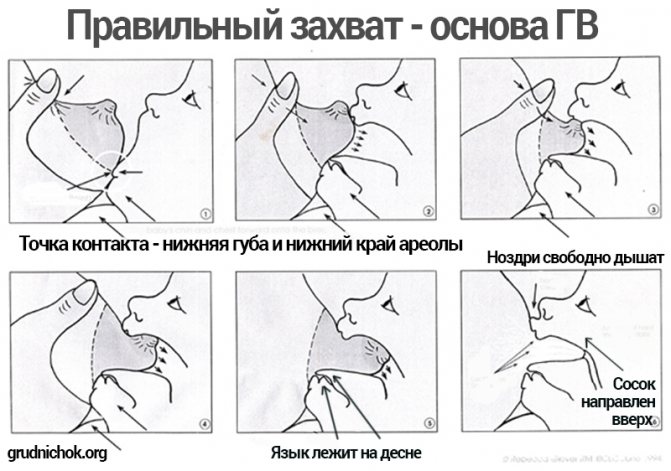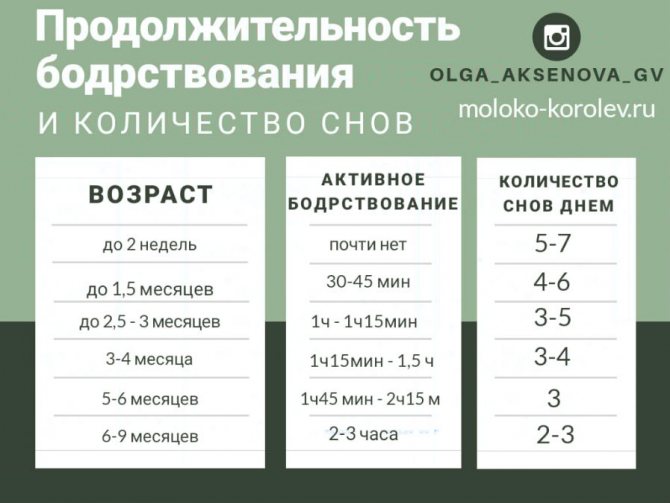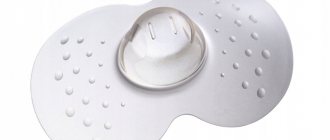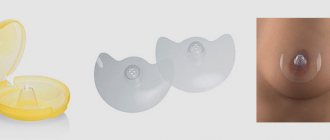09/23/2019 Reading time: 5 min 10928 0
The main reasons for a mother's refusal to breastfeed
The main reasons for a child's refusal to breastfeed
How to wean a baby?
Breast milk contains more than 500 beneficial components. All of them, once in the baby’s body, perform certain functions. Thanks to breast milk, the central nervous system and beneficial intestinal microflora are fully formed. The child’s immune system strengthens, which allows for protection against many diseases. Therefore, experts recommend breastfeeding (BF). No artificial milk formula can fully replace it.
Why does a child refuse the breast?
The reasons may be trivial, or they may not be so obvious.
Bottle
One of the baby’s main needs is nutrition and satiation. And if it is regularly or occasionally satisfied with a bottle, the baby may refuse to breastfeed. When feeding from a bottle and from the breast, different groups of facial muscles work, and the tongue also moves differently. The bottle is “easier” to handle; it always flows at the same speed. And if you tilt the bottle well, the milk will generally pour in on its own. When there is a tide, the chest also flows well, but the tide ends, and then you need to take a drop at a time. It is not surprising that many children refuse in favor of simplicity, because they are big conservatives.
Dummy
Mother's milk contains factors that are not associated with satiety, including sedatives and even painkillers. Therefore, it is normal for a baby to suckle at the breast to calm down and fall asleep. However, if you constantly replace the breast with a pacifier for these purposes, the baby will, of course, get used to it. Very often I encounter refusals that began after the mother gave a pacifier, “so as not to accustom the child to hang on the chest” when going to bed.
Stress or fear
Sometimes it seems that loving parents cannot do anything that will frighten or alarm the baby. However, it doesn’t take much for stress hormones to begin to be released. A child easily becomes stressed if something happens to him for which he is not ready, something he does not expect, and something for which he is not physiologically designed. For example, too active physical activity: diving, hardening, dynamic gymnastics and even massage, especially if these manipulations are performed through crying.
Painful medical procedures, such as blood draws or vaccinations, can cause fear. For particularly sensitive babies, even a routine visit to the doctor, a noisy crowd of guests in the house, moving from place to place, or apartment renovations can be a reason for giving up breastfeeding.
The reason for refusal may be quarrels in the family, especially if the mother screams or someone shouts at the mother when the baby is in her arms. Some infants may begin to worry under the breast even in response to discomfort during seemingly harmless procedures - using a gas tube or thoroughly cleaning the nose.
Of course, stress is an eternal companion in our lives: it is impossible to protect a child from it completely. However, stress comes in different levels and durations, and the strength of the nervous system of all children is also different. For example, with some diving methods, when water gets into the lungs, the baby may experience a real fear of death. However, even after such manipulations, not every child refuses to breastfeed. For others, it is enough that parents maintain the temperature in the apartment no higher than +18 for the purpose of hardening. The need for warmth in the first weeks and even months of life is very high.
Therefore, it is very important to choose care methods with your child in mind. If you notice any uneasiness under your breasts, they may not be the right fit for you.
Ignoring needs
If a child experiences severe discomfort, he does not have many ways to express his negative feelings. The younger his age, the fewer opportunities he has to interact with the outside world and ways to attract attention that something is wrong with him.
Most of the baby's needs are related to contact with his mother and breastfeeding. Food, warmth, safety, acquaintance with emotions, satisfaction of cognitive interest - at first he can get all this only in contact with his mother (or with an adult who replaces her). After birth, he is completely helpless and dependent, even compared to the young of other mammals. Therefore, he most of all needs a quick response to his needs. When this response is delayed, the baby begins to worry and then cry. And if the need is not satisfied chronically, frustration arises.
Postpartum depression or illness of the mother, as well as other conditions in which she simply cannot “monitor” the baby and meet his needs in a timely manner can lead to the child’s frustration. Often, a child refuses to breastfeed due to feeding according to a schedule, when the mother is guided by the clock, does not respond to searching behavior, rocks to sleep when crying, instead of feeding. However, too frequent, obsessive attachments can also cause refusal behavior. After all, the child’s signal was misinterpreted and forced to eat when he wants something else. Children are very sensitive to pressure.
Separation from mother or transferring care of the baby to another person
The baby knows his mother very well, her smell and voice even before birth. The first time after childbirth, he does not separate himself from his mother at all, does not know the boundaries of his body, and does not feel outside of interaction with her. He has a biological expectation that she will help him adapt to this world, will feed, warm, protect and care. But if another figure appears instead of the mother, the baby can transfer all these expectations to the “substitute” in the same way as he transfers the satisfaction of the need for sucking and saturation to the pacifier and bottle.
It is not necessary that if any of the listed factors are present, the baby will refuse to breastfeed! Every child, every mother and every family has its own characteristics. But if the baby has stopped quietly feeding from the breast, it is worth thinking about this list, because finding and eliminating the cause is one of the main conditions for overcoming the refusal!
Eliminating physical causes of failure
We treat ailments
If you suspect that breast refusal is caused by a painful physiological condition (there are other symptoms), contact your pediatrician . It is important to establish a diagnosis and carry out therapy as soon as possible.
We refuse any breast substitutes
The first thing to do if your baby stops latching is to remove any pacifiers and nipples . With a pacifier the situation is simpler: the sucking reflex is satisfied during feeding. If your baby needs to be fed or supplemented with water, do not use a bottle. Use a spoon or a plastic syringe (without a needle), try using a sippy cup.
We apply it correctly
When attaching your baby, make sure that:
- the head is not thrown back or turned to the sides, the chin is not pressed to the chest;
- the mouth is wide open so that in the grasping position the lips are turned outward, and dimples form on the cheeks during sucking;
- baby grabbed the areola, not the nipple
- To start feeding, bring the nipple to the corner of your mouth. The baby will reflexively open his mouth and turn towards the chest

Changing the feeding position when there is abundant milk production
If the baby is choking while trying to latch onto a breast that is full of milk, change the position so that the breast is lower than the baby's head during feeding. Try placing your baby on top of your chest while lying on the bed. Make sure that the baby's nose is not covered by the mammary gland. Also, express some of the milk before feeding.

Stimulating milk production during weak lactation
If your baby refuses to breastfeed because he has to exert too much force to suck the milk, try to relax as much as possible before feeding. Take a warm shower, thinking about the upcoming communication with your baby. Massage your breasts in the direction of the milk flow. Try massaging your breasts a little before feeding to stimulate more active milk production and flow. You can also feed in an overhang position so that gravity helps your baby suckle.

False breast refusal
To understand whether the reason for refusal is truly psychological, I usually ask the mother to tell me how the baby sucks while sleepy. If he sucks calmly in his sleep or, for example, only at night, then that’s how it is – it’s a matter of emotions. This is suitable for a situation where the refusal is loyal (that is, the baby takes the breast from time to time).
But if the child does not breastfeed even in his sleep, and this behavior appeared abruptly, yesterday everything was fine, and today he wakes up and cries when trying to feed, then perhaps there is another reason.
Severe physical discomfort
There are conditions in which the child’s behavior looks like refusal, but the essence is different. With a severe runny nose, stomatitis or thrush in the mouth, sore throat or otitis media, the baby may become nervous when feeding or stop feeding altogether due to pain when sucking. Severe physical discomfort that causes the baby to stop eating may not be related to feeding: for example, diaper rash or skin irritation. To resolve these problems, you must contact the appropriate doctor.
Colic
Separately, I would like to talk about colic. Nowadays, some parents call everything “colic.” Any intestinal problems, sometimes any crying. In fact, colic is when a baby cries as if in pain - inconsolably, strongly, for no apparent reason. He may calm down and suck at times. But while crying, it is impossible to calm him down with your breasts, and there is no need to use screaming!
Colic usually occurs at certain hours, often in the evening, especially before bedtime. They pass as suddenly as they began, as if a switch was turned. Before and after the time “H” comes, the baby suckles completely calmly. Don't confuse this with breastfeeding! Here, rather, you need to contact an osteopath. Because colic is about tension in the body, so unbearable that the child cries as if in severe pain. There is a version that colic is an “infant migraine”, but the phenomenon has not been fully studied, and medicine has no official answer. Another controversial version is that colic may be related to care: it may be a source of stress for the baby.
Urge to urinate and defecate
When the urge to empty the bladder and bowel movements occurs, the baby may drop the breast and whine. This is one of the main needs, and many children prefer to cope with it without a pacifier in their mouth. To help the baby at this moment, it is better to learn how to disembark.
An older baby is distracted from the breast
Around 3 months, the baby sometimes begins to be distracted from the breast. He can interrupt feeding if someone enters the room or the wind simply blows through the window. This is fine. The baby has begun a new round of development; he now sees and hears, almost like an adult. He discovers so many new things in the world around him that sometimes it’s overwhelming! In principle, you don’t need to do anything here at all, just create a calm environment when feeding for sleep.
Teething
Teeth often cause great discomfort to the baby long before they appear on the gums. He begins to suck very restlessly, often even in his sleep. This is a separate topic, here I will only say that gels with lidocaine (Kalgel, Kamistad, Dentinox) cause complications and are prohibited for use in infants since 2014 by the Food and Drug Administration (American organization of the Food and Drug Administration). Look for another way out.
The child refuses one breast
This phenomenon most often has not psychological, but physiological reasons. Sometimes a baby is more comfortable sucking on one breast than the other. The sooner you notice this, the greater the chances of avoiding “one-sided” feeding, because in response to more productive sucking in the “favorite” breast, lactation will begin to increase, and in the “unloved” breast it will begin to fade.
The reason may be that one breast has an inverted, flat or less “elastic” nipple, which is harder for the baby to hold in the mouth. Or perhaps he is uncomfortable lying on that side due to problems in the body's structures, such as torticollis. Or the “unloved” breast is distinguished by its glandular capacity and produces less milk. In these cases, you need to select feeding positions and the method of “breastfeeding” individually, with which a lactation consultant can help.
However, it also happens that nothing can be done about it, for example, when, due to scoliosis or surgery in the chest area, the mother’s nerve endings near one breast are damaged. It simply may not have the oxytocin reflex (that is, the milk will always flow drop by drop and there will never be a “tide” - the milk separation reflex), and the baby will prefer the other breast.
Lactase deficiency
Sometimes a child’s behavior with lactase deficiency is mistaken for breast refusal. If he takes the breast calmly, but quits crying after eating the first portion of milk (inconsolable crying, as if in pain), then perhaps the reason is poor absorption of milk sugar - lactose and a lack of the enzyme lactase.
However, children refuse breastfeeding quite often, and true lactase deficiency is a very rare disease. This is probably why in my practice there are more often situations when breast refusal is mistaken for an illness. It happens that they even prescribe an enzyme for crying under the breast if a high sugar content is found in the baby’s stool (which in itself is not an exhaustive confirmation of the diagnosis of LI).
In order not to fall for this bait, you need to look at the totality of all the symptoms and observe whether the behavior changes depending on the enzyme? Why continue to give medication if the child is still worried? To help, it is better to find a doctor with a natural approach who is not inclined to prescribe excessive treatment.
Causes of physical failure
In case of true breast refusal, you need to look for a material reason - a painful condition, a physical difficulty or obstacle.
Using pacifiers and pacifiers
All kinds of mother’s “helpers” that can calm a crying baby or facilitate the process of supplementary feeding or supplementing from a bottle are not always compatible with the process of breastfeeding. A pacifier, which is offered to a baby between feedings, satisfies the sucking reflex, but nature has not invented such “technical devices.” The child satisfied his needs during the feeding process. In addition, the shape of even the most physiological nipple or pacifier is not similar to the breast, and in the process of sucking the baby gets used to making efforts of a different nature, placing his lips and tongue differently. In the future, this can lead to breast refusal. In the case of bottles, there is another aggravating factor: less effort is needed to get milk through the nipple. If the baby understands this, then natural feeding will be in jeopardy. For more information about when you should use a pacifier and when it is best to avoid it, read the article The benefits and harms of pacifiers
Physical illness
Colic: When the tummy is bloated, the baby cannot concentrate on sucking, even if he is very hungry. Runny nose: During the first six months of life, a newborn is only able to breathe through the nose. In addition, a child's nasal passages are very narrow and tend to close very quickly if the mucous membrane swells or discharge appears. A runny nose interferes with breathing, particularly during feeding. Thrush in the mouth: the development of a fungal infection in the baby’s mouth causes discomfort during sucking. If the baby abandons the breast and is capricious, check if there are whitish areas with a cheesy coating on the mucous membranes. Otitis: If your little one's ears hurt, feeding hurts. The baby has short ear canals, and during sucking, a vacuum is formed in the oral cavity, which causes pain in the ears.
Incorrect attachment as a cause of failure
Inexperienced mothers often have no idea that their child is refusing to breastfeed because their feeding process is not organized correctly. If the baby only latches onto the nipple, there will be no milk. To activate the milk supply process, you need to squeeze the areola. In this case, the mouth should be wide open, and a vacuum should form in the oral cavity. Read more in the article about proper breastfeeding.
Milk flow too strong/weak
If the breast is full and the baby is below the level of the mammary gland, then during feeding the milk may flow excessively abundantly and actively. The baby will choke. In the opposite situation, when there is not enough milk in the breast, or the woman is tense, the baby makes incredible physical efforts to suck out the fluid. In both situations, the baby may begin to refuse, and both need correction.
LACTATION CRISIS. A lactation crisis is a certain stage of feeding, usually corresponding to a growth spurt in a baby, when the amount of milk in the mother has not yet adjusted to the new needs of the child. The first lactation crisis usually occurs in the third month of a child’s life. This is a separate case, and read about it in a separate article.
All of the above reasons for refusal can be eliminated with a competent approach. To restore natural feeding, it will take 1-2 weeks, and compliance with the recommendations appropriate to the situation.
What to do if the baby refuses to take the breast?
What if this is true breast refusal and not false? If the reasons really lie in the baby’s emotions?
Here are the key points of the method I work with, which in most cases has quick results.
Restoring natural sucking rhythms: around dreams
Natural feeding is based on certain rhythms. The baby needs the breast when coming out of sleep and when going to bed. Babies also suck in the middle of sleep, when the “deep” phase gives way to the “superficial” one.
It is at these moments that the baby shows desire and readiness to breastfeed. He begins to fidget, as if he were about to crawl somewhere, sticking out his tongue, licking his lips, or moving his head with his mouth open. This is called "searching behavior" because the baby is looking for the breast in this way.
A baby who refuses to suck will also demonstrate a search, but when he finds the nipple, he may become upset and cry. Search behavior is reflexive; it is the main assistant in overcoming breast refusal. It is at these moments, when the baby is looking for the breast unconsciously, that it should be offered!
Dreams next to mom, sometimes in mom’s arms
The most favorable moment to insert the breast is in the superficial phase of sleep. The baby is unconscious, but ready to suck, emotions are turned off, and reflexes are working!

In order not to miss this phase, the mother needs to be nearby while the baby is sleeping. During daytime dreams, it is better to hold the child in your arms and catch the “moment” when he begins to fuss and open his mouth. You also need to arrange for the baby to sleep at night close to the mother, at arm's length, so that she can hear when the baby starts to wake up and fidget. Often it is at night, in shallow sleep, that babies begin to suckle after a long and categorical refusal. But you need to have time to react before the baby wakes up completely.
When offering the breast in a dream, we do not know whether the baby will wake up after feeding or continue to sleep. If he sucks and continues to sleep, at least he will eat. If he wakes up with a breast in his mouth, even better! After waking up on the breast a few times, babies begin to behave much calmer when feeding.
Do not put pressure on the child!
When the baby takes the breast in a dream, or even better, wakes up with the breast in his mouth, this is a very important moment for overcoming refusal. But if the attachment does not take place, there is no need to insist! Be careful not to wake up your baby by struggling! Pressure can only make resistance worse. It’s better to stop trying and let him sleep in his mother’s arms until he next enters the surface phase or wakes up.
Breast wrestling should be avoided at all costs. Under no circumstances try to latch on by screaming, because this only reinforces the baby’s negative emotions towards the breast.
Children's resistance to sucking in a conscious state is always greater than in sleep. Therefore, during periods of active wakefulness, it is better not to offer breasts at all. You can give it if the baby strongly demonstrates searching, but immediately take it away if he starts to worry or cry. This period should be filled with communication in forms that are appropriate for your child’s age and development.
Adjust the duration of wakefulness
It is very important to know what duration of active wakefulness is the norm at this age of the baby? By three weeks, when “emotional refusal” of the breast may occur, babies usually “walk” between naps for 30–40 minutes. At 1.5–2 months it’s already 45 minutes – 1 hour. At 3 months - from 1 hour 15 minutes. up to 1 hour 30 minutes At 4–6 months - up to 2 hours. Before a night's sleep, the period of wakefulness may be slightly longer than at other intervals.
If a child is excessively partying, this will worsen the “refusal behavior.” I often come across babies who, at the age of one month, do not sleep for 2-3 hours between naps and go to bed, as they say, “fighting.” “Going overboard” results in severe physical and emotional stress. This prevents the child from falling asleep. Adults, remember yourself: how difficult it can be to relax when you are very overtired!
To overcome refusal, you need to eliminate the “overnight” between naps.
The baby needs to get help from his mother in time: she can create conditions for falling asleep easier. If the baby is a month old, then you need to start putting him to sleep 30-45 minutes after waking up, if 2 months - after 45 minutes - an hour, etc.

If your baby cries and arches under your breast, adjust the intervals of wakefulness so that he does not overdo it.
To more accurately understand when it’s time for your baby to sleep, focus on the first signs of fatigue: “stagnant gaze,” irritability, overexcitement. Some children are too active before bedtime, they may make loud noises and wave their arms. Others, on the contrary, “freeze” with their gaze and slow down. Still others begin to whine. And, of course, a marker of fatigue can be the activation of “search behavior”, when the baby very persistently begins to suck on the fist or the edge of the diaper, intensively lick his lips, etc. By carefully observing your baby, you can learn to very accurately calculate this moment.
It is during bedtime that children usually resist feeding the most due to fatigue and tension. And sometimes they even resist sleep itself! Therefore, here the most difficult task arises.
Put your child to sleep without a scandal and a pacifier
Yes it is possible! You just need to create certain conditions for your baby to fall asleep.
Anything that reminds the baby of the sensations he received in the womb - in an ideal world where he felt protected and his needs were fulfilled automatically - has a calming effect on him.
- Swaddling is tightness, like in the womb.
- Motion sickness - like when my mother walks.
- White noise is like the monotonous sound of my mother’s internal organs working.
- Dimmed light - the baby lived in the dark for 9 months.
- And the baby also sucked his finger in the womb.
Sucking is also soothing. But what if the baby doesn’t take the breast at all and only gets more nervous when the mother offers it?
To start, try getting your baby to sleep without the breast using 4 other techniques: rocking, swaddling, white noise, and dim lights. “White noise” sometimes produces a simply miraculous effect, fortunately, every home is full of its sources: water in the tap, an electric kettle or a hairdryer, there are applications for iPhones and Androids like “Baby Sleep” with its various options.
The main thing is that the baby falls asleep: he can kiss in an unconscious state without any resistance.
Most people do just that. Moreover, having taken the breast during sleep, the child can already hang on it before waking up.
But what if the baby is used to falling asleep with a pacifier and cannot calm down without sucking? There is also a little trick. You can give your baby your finger with the pad to the palate (directly touch the arch of the palate, there is a reflex point that triggers the sucking reflex), with a nail on the tongue.
Why is a finger better than a pacifier? Because the finger helps the baby make a wave with his tongue - the same as when sucking the breast. A pacifier, on the contrary, forces you to group your tongue in your mouth and move it up and down, like a piston. Thus, by giving a finger, we train the child to develop the sucking pattern necessary for breastfeeding.
Close physical contact is required
For two weeks—exactly as long as necessary to consolidate calm sucking—the mother should not be separated from the baby. Moreover, the baby should spend most of the time in his arms. He needs to get used to the fact that his mother is always nearby, and that the breast is always available.
When all cycles - sleep, wakefulness and sleep at night - occur in the same and predictable manner next to the mother and the breast, this gives the baby a sense of stability. He begins to accept such close contact and breastfeeding as normal.
The smaller the baby, the better the stimulation of searching behavior through skin-to-skin contact works. However, this does not mean that you should spend all your time in bed with your baby bare-breasted. Moreover, you don’t need to offer your breasts all the time. This is much more important.
Establish psychological contact with the child and quickly respond to his needs
After three weeks, the baby develops a revival complex - he is already able to look at his mother with concentration, listen to her when she addresses him, and is able to respond with a smile to a smile. These are the first experiences of communication, which are very important for the child’s entire next life.
When working on refusal, you need to pay attention to the quality of this communication between mother and baby, and not just mechanically follow the recommendations. You need to look eye to eye, speak words of love, give positive verbal instructions for breastfeeding. React as soon as the baby’s mood changes, trying to understand the reason. During the waking period, nursery rhymes and games help to establish contact.
A quick response to his signals is very important for your baby. Until the age of 1.5 years, he does not know how to tolerate and delay the satisfaction of needs. If he wants to sleep, a delay of 15 minutes can cause severe fatigue. And if he begins to whine and does not receive consolation right away, then in less than a minute he may start screaming and blush from tension.
Minimize stress for mother and baby. Do not introduce any new elements into child care
Stress itself can cause your baby to feel uneasy under the breast. But even if the reason is different, for example, supplementary feeding from a bottle, it should be eliminated or at least reduced (as much as possible).
Diving and dynamic gymnastics, swimming with a circle around the neck, painful medical procedures, moving and preparing for them, living in repair conditions, constant noise, low room temperature, temporary or regular transfer of the child into the wrong hands can interfere with the work on “refusal”, the presence of strangers in the house (even if the baby is in the mother’s arms), sometimes teaching methods based on unconscious memorization.

Given that children are very conservative, any new elements in care or changes in the environment can cause a stress reaction in them.
If a nursing mother is stressed, this can also ruin all the work to overcome the refusal. The baby feels his mother’s anxiety by the smell of her body, by the rhythm of her breathing and heartbeat. Mom’s anxiety deprives him of a sense of security, then he also becomes more nervous.
Solution: strive to control your emotions, breathing and posture. This, of course, requires strength. Mom needs to understand what the resource gives her? How can she rest or recharge with her baby in her arms? Perhaps watching your favorite TV series or listening to your favorite band in the background? Maybe hire an au pair and hand over household chores to her?
If a mother cannot cope with her feelings on her own, it is necessary to seek professional psychological support.
NEW LEVEL
Nancy Mohrbacher is a lactation consultant from the USA, IBCLC, FILCA. Mother of three breastfed sons. She began her professional activity in 1982. Author of several textbooks on lactation and books for parents, including Breastfeeding Answer Made Simple, from which this article was translated. Her website is https://www.nancymohrbacher.com/
Breast refusal after birth
If a baby refuses one or both breasts at birth, the first step is to ask the pediatrician to rule out medical causes, such as torticollis, birth trauma, unusual oral anatomy, and other conditions.
Refusal of one breast. Possible causes and strategies :
1. Difference in nipples.

If one nipple is more or less pronounced than the other, your baby may latch on to one breast and refuse the other. The same thing can happen if the baby prefers the size or tissue structure of one nipple over the other.
In order to help the baby latch onto both breasts, it is advisable to use a reclining position leaning back (“relaxed or biological feeding” - editor’s note), thereby triggering an innate behavior in which the baby plays an active role in latching on to the breast.
Another strategy is to use breast support and shaping to make it easier for the baby to latch deeper on the “unloved” breast. The asymmetrical application technique can also help.
2. Breast density.

If one breast is consistently tighter than the other, your baby may have difficulty latching on deeply and may become fussy about it. It is advisable to begin feeding by using the "pressure softening" technique, softening the areola before giving to the breast. Expressing a small amount of milk to soften the breasts may also help. Breast support and shaping can be used.
Some newborns feel discomfort when they are held in a certain position and may be tempted to take the “unloved” breast in a position that is more comfortable for them. Typically, the baby's head is positioned in one direction when he is on the right breast and in the other direction when he is on the left. When using different positions, you can move the baby to the other breast without changing the position of his body to see if there is a difference in feeding (for example, when feeding from under the arm, the baby will be in the same position at the right breast as at the left breast in a standard "cradle" position - editor's note).
Babies are likely to refuse one breast if they have torticollis and cannot turn their head easily, or have had a birth injury and feel pain in certain positions, or have recently been immunized.
In some cases, feeding on one side occurs more gently, as the mother better coordinates the movements of her dominant hand.
3. Different amounts of milk in the breasts.
The child prefers a fast flow. In this case, you can stimulate the milk ejection reflex before offering the breast that he refuses, then he will not have to wait. (Usually, to stimulate the flow, it helps to either make several pumping movements, or exposure to heat - put a warm compress, a heating pad on the chest for a few minutes, or just drink a hot drink. - Ed.).
The child prefers a slow flow. In this case, it is advisable to use a reclining position for the breast, which the child refuses (“relaxed feeding” in the photo above. - Ed.). The baby can lie on the mother with his tummy down. The tummy-down position (due to gravity) gives the baby more control over the strong flow of milk and makes it easier for him to suckle.
Overfilling of the breast and prolonged stagnation of milk can cause refusal of one breast at any age. It may be difficult for a baby to latch deeply on an overfilled breast. Long-term milk stagnation or mastitis can change the taste of the milk, it may become salty and the milk flow may become weak.
Many mothers breastfeed twins, triplets and older babies, so most mothers can easily produce enough milk at one breast to satisfy the baby. But in this case, the mother should expect the baby to latch on more often if only one breast is used.
Single-breastfeeding moms worry about whether their breasts will be the same size in the future. This is because the working breast can become significantly larger in size than the other. In this case, you need to know that after weaning, the breasts will become the same size as they were before pregnancy. If they were the same size before pregnancy, then the mother can expect that they will become the same after the end of breastfeeding.
If a mother wants to establish feeding from a refusing breast, then it is necessary to express milk from this breast several times a day so that there is enough milk in this breast.
General recommendations:
1. Start feeding from the breast that the baby prefers and after the appearance of hot flashes, move the baby to the other breast without changing the position of his body. 2. Offer the unloved breast after stimulating milk flow. 3. Experiment with different positions, starting with a reclining position on the back, with the baby tummy down. 4. Help the child by supporting the breast and forming a sandwich out of it (in our country this is more often called “forming a fold on the chest with a pie.” - Ed.). 5. Try feeding in a dark room. 6. Move the baby to the “unloved breast” while walking or rocking to distract him. 7. If the child eats only from one breast and gains little weight, and the mother does not have expressed or donor milk, then it is necessary to supplement the child with formula.
Several articles have found that sudden rejection of one breast for no apparent reason is a possible indicator of breast disease. Therefore, it makes sense to see a doctor.
Refusal of both breasts in the first weeks
If refusal begins between the second and fifth days, the cause may be engorgement of the breast or a delay in milk supply, which causes stress in the baby.
If refusal begins within the first month and the child received breast substitutes (bottle and pacifier), then they may have been a precipitating factor for breast refusal.
Some babies will refuse to breastfeed if their mouth and nose were roughly cleaned immediately after birth or if they were placed roughly at the breast. In some cases, mothers are so motivated to breastfeed that they make many attempts to put their babies to the breast, despite the fact that they are upset. There are babies who latch well to the breast after such an experience, but some may have negative associations, which is the reason for refusing to breastfeed. In the latter case, it is necessary to take time to create the impression that the chest is a pleasant place.
Babies often refuse the breast if they are not put to the breast when they want it; if there is no feeling that the breast is deep in the mouth; if the mother has a very slow or very fast milk flow; if the mother has a hard nipple (for those babies who were bottle-fed and given a pacifier).
In some cases, all that is needed to resolve a refusal problem is to improve your latching technique. At times when the baby is not very hungry, it is necessary to take a comfortable position, for example, a reclining position, and put the baby on top, thereby triggering his innate behavior and allowing the baby to take the breast himself.
If the baby does not take the breast deeply, then his tongue does not receive sufficient stimulation to initiate active sucking and this leads to anxiety in the baby. In this case, the mother needs to take a more active role and help the baby latch deeply using breast shaping and asymmetrical latching.
If the baby was bottle-fed and he began to worry about the softness of his mother’s breasts, then it is necessary to use breast shaping and support.
In some cases, squeezing out a drop of milk or using silicone pads can help.
Strike (giving up breastfeeding a few weeks after birth)

The term strike means that the baby was feeding well from the breast, but suddenly began to refuse the breast completely. Some mothers whose children refuse to breastfeed suggest that this is an option for weaning. However, if the child is under one year old, then he has a physical need for his mother's milk. The difference between self-weaning and a strike is that the baby is unhappy when weaning. Typically the strike lasts 2-4 days, but can last as long as 10 days, and may require ingenuity, wisdom and careful analysis to find the cause and help the baby return to breastfeeding.
Sometimes the reason cannot be found. But it is useful to look for the reason. The range of breast refusal is wide: some babies become fussy at the breast, others refuse to breastfeed completely. The reasons for breast refusal are divided into two groups.
1. Physical causes: - ear infection, cold or other diseases - gastroesophageal reflux, which causes pain during feeding - increased milk production, and as a result, a very rapid flow of milk - hypersensitivity, allergies - pain after an injury, medical procedure, injection - pain in the mouth during teething, thrush, mouth injuries - reaction to cosmetic products: deodorants, lotion, perfumes
2. Environmental factors: - stress, frustration, overstimulation, chaotic home environment - feeding on a schedule or frequent interruptions of feeding - the baby is left crying for a long time - many changes in the child's daily routine - for example, traveling, mother returning to work - arguing and agitated communication during feeding - a strong reaction from the mother when the child bites the breast - an unusually long separation
If the reason is found, this is reassuring and influences the choice of strategy. If the cause is not found, then you can choose from the most common strategies:

1. It is necessary to express milk as often as the baby was fed from the breast in order to avoid breast overfilling and maintain milk production at the same level. To supplement feeding, you need to choose a method that is suitable for the child’s age.
2. If the baby is 6-8 months old, cup feeding is advantageous because it does not satisfy the baby's need to suck like a bottle does. Without sucking on substitute objects, the baby may be more motivated to return to breastfeeding. A child younger than this age can be supplemented with a cup or spoon. If mom avoids giving pacifiers and bottles, it may shorten the strike time. If a child is given a pacifier, it must be removed.
3. The chest should be a pleasant place, it should not become a battlefield. If feeding is stressful, find an opportunity to feed the baby in another way, and arrange cuddles on the chest, and give the baby the opportunity to sleep on the chest.
4. Touch your baby as often as possible and have skin-to-skin contact. Between feedings, it is better to hold the baby in your arms and if the baby likes it, then be skin to skin. This calms both mother and baby, and the oxytocin released during skin-to-skin contact makes the interaction more open.
5. Offer your baby the breast when the baby is half asleep or sleepy. Some babies latch on easier when they are relaxed or falling asleep.
6. Use feeding positions that baby loves and experiment, starting with the reclining position.
7. Trigger the milk release reflex before giving the baby the breast, or express milk onto the baby's lips.
8. Try to form the breast into a fold and support it, this will help the baby take the breast deeper and start active sucking.
9. Try to feed the baby while moving - walking and rocking him.
10. In those moments when the baby eats well, stay with him as long as possible.
11. Supplement your baby if the weight gain is small or the baby is not gaining weight. This is necessary to ensure that the baby receives the amount of milk he needs and is open to breastfeeding.
12. If the baby is attached to the breast, but does not want to linger on it, ask an assistant to drop expressed milk onto the breast or into the corner of the baby's mouth. Swallowing will trigger the sucking reflex and this will help the baby to start sucking at the breast. If the baby comes off the breast, add a little more milk.
13. Give some expressed milk to your baby before offering the breast. Children are often more cooperative when they are not hungry. You can feed your baby one-third or half of his usual supplementary feeding and then offer the breast. Another variation of this same approach is called “bait and switch.” In this case, the mother begins to bottle-feed the baby in the breastfeeding position, and when the baby begins to actively suck and swallow, she takes the bottle and offers the breast.

14. If the baby is used to eating in the cradle position, you can try putting him on a pillow and offering the breast. Sometimes it happens that babies resist being tightly pressed to their mother’s body, but agree to eat while lying on the pillow.
15. Try using thin silicone pads. In some situations, silicone shields may be a device that will preserve breastfeeding. Consider this option if:
- the child does not take the breast after being fed from a bottle and using a pacifier;
- the child has a short frenulum of the tongue or unusual movements of the tongue;
- Mom has inverted nipples;
- the baby was born prematurely and cannot breastfeed effectively or cannot stay on the breast.
Translation made from the book “Breastfeeding answers made simple”.
With the official permission of the author, translated by Irina Zyryanova , breastfeeding consultant, IBCLC Yekaterinburg, https://milkyhelp.ru/
Editorial processing of the text - Irina Ryukhova for “New Level”. Photos of Olga Ermolaeva were used specifically for the “New Level” project.











